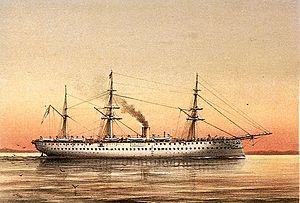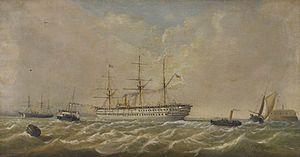HMS Crocodile (1867) facts for kids
class="infobox " style="float: right; clear: right; width: 315px; border-spacing: 2px; text-align: left; font-size: 90%;"
| colspan="2" style="text-align: center; font-size: 90%; line-height: 1.5em;" | 
|} HMS Crocodile was a large ship called a troopship. It was built to carry soldiers and their families across long distances. The ship was part of the Euphrates class and was launched into the Thames River on January 7, 1867. It was built by Money Wigram and Sons and was the fourth ship in the Royal Navy to be named Crocodile.
Contents
| History | |
|---|---|
| Name | HMS Crocodile |
| Ordered | 1865 |
| Builder | Money Wigram and Sons |
| Launched | 7 January 1867 |
| Fate | Sold 11 May 1894 |
| General characteristics | |
| Class and type | Euphrates-class troopship |
| Type | Troopship |
| Displacement | 6,211 tons, 4,206 tons BM |
| Length | 360 ft (109.7 m) (overall) |
| Beam | 49 ft 1.5 in (15.0 m) |
| Depth of hold | 22 ft 4 in (6.81 m) |
| Installed power |
|
| Propulsion |
|
| Sail plan | Barque |
| Speed | 15 kn (28 km/h) |
| Armament | Three 4-pounder guns |
Ship Design and Features
The Crocodile was one of five ships in the Euphrates class. These ships were made of iron and were all very similar in size. They were about 360 feet (110 meters) long and 49 feet (15 meters) wide.
Key Design Details
- Propulsion: Each ship had a single propeller and could reach a speed of 14 knots (about 26 km/h).
- Sails: They also had sails, set up like a barque, to help them travel.
- Appearance: All ships had one funnel and were painted white.
- Bow: A special feature was their "ram bow," which stuck out underwater at the front of the ship.
- Armament: For defense, they carried three small 4-pounder guns.
How to Tell Them Apart
Each ship in the Euphrates class had a different colored band painted on its hull (the main body of the ship). This helped people tell them apart. The Crocodile had a yellow hull band. Interestingly, the blue hull band of its sister ship, the Euphrates, later became the standard color for all Royal Navy troopships.
Service and Journeys
The main job of the Crocodile was to transport soldiers and their families. It traveled between the United Kingdom and India. A single trip usually took about 70 days, and the ship could carry up to 1,200 people.
Notable Incidents
- Collision: On November 27, 1867, the Crocodile was involved in a collision. It hit a Canadian merchant ship named John Dwyer in the English Channel. The John Dwyer sank, and four of its crew members were lost. The Crocodile was able to rescue the survivors.
- Engine Upgrade: Later in its life, the Crocodile received a new, more efficient steam engine. This made it better at saving fuel.
- Rescue Mission: In December 1888, the Crocodile helped another ship in trouble. It towed the Dutch steamship Sourabaja to Malta after its engine broke down near Cape Trafalgar, Spain.
Final Voyage
The Crocodile began its last journey in October 1893, leaving Bombay (now Mumbai) in India. On November 3, as it was nearing Aden, a part of its steam engine exploded. The ship stopped moving. The next day, it was towed to a safe spot near Aden. Most of the soldiers and their families on board were transferred to other ships to complete their journey home. The Crocodile eventually made it back to Portsmouth, England, on December 30, 1893, using only one part of its engine. After this, it was no longer used to carry troops.
End of Service
The Crocodile was sold on May 11, 1894. It was then broken up for scrap.


